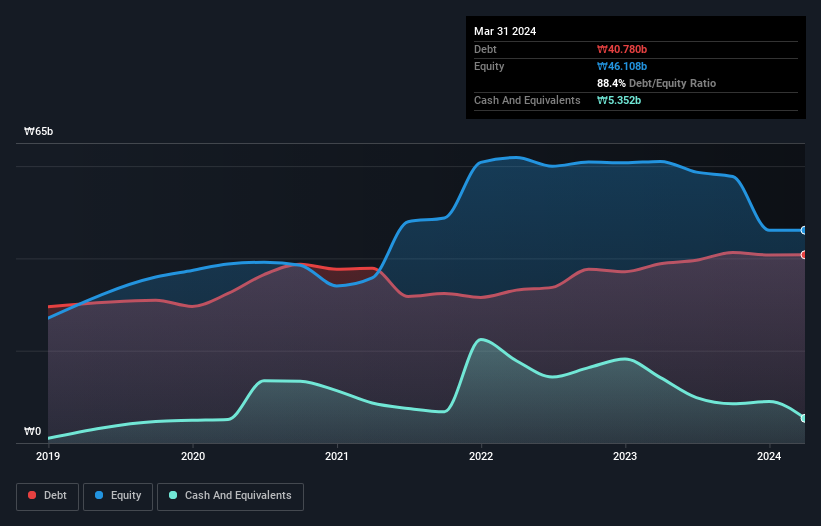- South Korea
- /
- Metals and Mining
- /
- KOSDAQ:A186230
We Think Green Plus (KOSDAQ:186230) Has A Fair Chunk Of Debt
David Iben put it well when he said, 'Volatility is not a risk we care about. What we care about is avoiding the permanent loss of capital.' When we think about how risky a company is, we always like to look at its use of debt, since debt overload can lead to ruin. As with many other companies Green Plus Co., Ltd. (KOSDAQ:186230) makes use of debt. But is this debt a concern to shareholders?
What Risk Does Debt Bring?
Generally speaking, debt only becomes a real problem when a company can't easily pay it off, either by raising capital or with its own cash flow. In the worst case scenario, a company can go bankrupt if it cannot pay its creditors. However, a more usual (but still expensive) situation is where a company must dilute shareholders at a cheap share price simply to get debt under control. Having said that, the most common situation is where a company manages its debt reasonably well - and to its own advantage. When we examine debt levels, we first consider both cash and debt levels, together.
See our latest analysis for Green Plus
What Is Green Plus's Net Debt?
You can click the graphic below for the historical numbers, but it shows that as of March 2024 Green Plus had ₩40.8b of debt, an increase on ₩38.8b, over one year. However, it also had ₩5.35b in cash, and so its net debt is ₩35.4b.

A Look At Green Plus' Liabilities
Zooming in on the latest balance sheet data, we can see that Green Plus had liabilities of ₩41.2b due within 12 months and liabilities of ₩11.3b due beyond that. Offsetting this, it had ₩5.35b in cash and ₩13.7b in receivables that were due within 12 months. So its liabilities total ₩33.5b more than the combination of its cash and short-term receivables.
This deficit isn't so bad because Green Plus is worth ₩103.8b, and thus could probably raise enough capital to shore up its balance sheet, if the need arose. But we definitely want to keep our eyes open to indications that its debt is bringing too much risk. When analysing debt levels, the balance sheet is the obvious place to start. But you can't view debt in total isolation; since Green Plus will need earnings to service that debt. So if you're keen to discover more about its earnings, it might be worth checking out this graph of its long term earnings trend.
In the last year Green Plus had a loss before interest and tax, and actually shrunk its revenue by 23%, to ₩61b. To be frank that doesn't bode well.
Caveat Emptor
While Green Plus's falling revenue is about as heartwarming as a wet blanket, arguably its earnings before interest and tax (EBIT) loss is even less appealing. To be specific the EBIT loss came in at ₩8.5b. Considering that alongside the liabilities mentioned above does not give us much confidence that company should be using so much debt. Quite frankly we think the balance sheet is far from match-fit, although it could be improved with time. However, it doesn't help that it burned through ₩12b of cash over the last year. So suffice it to say we consider the stock very risky. When analysing debt levels, the balance sheet is the obvious place to start. But ultimately, every company can contain risks that exist outside of the balance sheet. To that end, you should learn about the 3 warning signs we've spotted with Green Plus (including 2 which are concerning) .
When all is said and done, sometimes its easier to focus on companies that don't even need debt. Readers can access a list of growth stocks with zero net debt 100% free, right now.
New: Manage All Your Stock Portfolios in One Place
We've created the ultimate portfolio companion for stock investors, and it's free.
• Connect an unlimited number of Portfolios and see your total in one currency
• Be alerted to new Warning Signs or Risks via email or mobile
• Track the Fair Value of your stocks
Have feedback on this article? Concerned about the content? Get in touch with us directly. Alternatively, email editorial-team (at) simplywallst.com.
This article by Simply Wall St is general in nature. We provide commentary based on historical data and analyst forecasts only using an unbiased methodology and our articles are not intended to be financial advice. It does not constitute a recommendation to buy or sell any stock, and does not take account of your objectives, or your financial situation. We aim to bring you long-term focused analysis driven by fundamental data. Note that our analysis may not factor in the latest price-sensitive company announcements or qualitative material. Simply Wall St has no position in any stocks mentioned.
Have feedback on this article? Concerned about the content? Get in touch with us directly. Alternatively, email editorial-team@simplywallst.com
About KOSDAQ:A186230
Green Plus
Engages in the manufacturing and sale of aluminum products and greenhouse materials in South Korea and internationally.
Low risk with questionable track record.
Market Insights
Community Narratives



